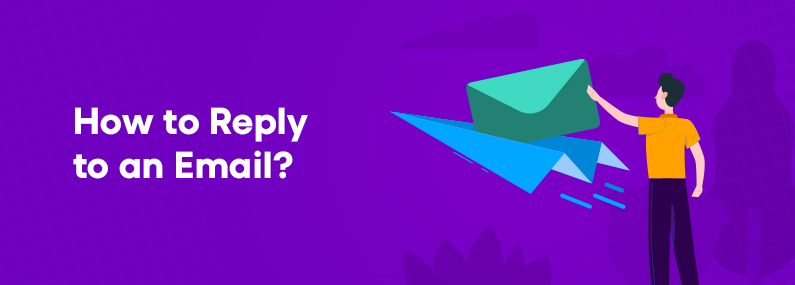Email has become the lifeline of modern workplace communication. Your ability to write clear, impactful replies can make or break professional relationships. This guide teaches you how to transform simple email responses into powerful communication tools.
Hitting “reply” is more than typing words. It’s about understanding context, tone, and professional nuance. Your email represents you—your brand, skills, and professionalism. Whether responding to clients, colleagues, or potential employers, every message matters.
We’ll discuss practical strategies that elevate your email communication. You’ll learn precise techniques to craft concise, confident, and compelling responses. From structuring messages to perfecting professional etiquette, this guide gives you the skills to communicate effectively in any business scenario.
1. When to Reply to an Email
Navigating email communication requires strategic timing and context awareness. Not every incoming message demands an immediate reply email, but understanding the subtle expectations is crucial for professional interactions.
Priority emails typically include direct questions, time-sensitive requests, or messages from leadership. When crafting an email reply format, assess the sender’s urgency and importance. Client or supervisor communications generally demand quicker responses than routine newsletters or group announcements.
In response to professional correspondence, aim to reply within 24-48 hours. This timeframe demonstrates respect, reliability, and professionalism. For urgent matters, acknowledge receipt immediately, even if a comprehensive response requires additional research or consultation.
Critical indicators for prompt replies include:
- Explicit time-bound requests
- Queries requiring critical decision-making
- Messages involving financial or contractual details
- Communication from key stakeholders
Remember, consistent and timely communication builds trust and reinforces your professional reputation.
2. Key Components of an Effective Email Reply
Knowing the key elements of a well-structured email reply ensures clear, concise, and impactful responses that maintain professionalism and enhance workplace relationships. Here’s a brief on the key components of a proper email reply:
2.1 Subject Line Strategy
Crafting an impactful reply email begins with a strategic subject line. When responding, determine whether to retain or modify the original thread for clarity. For ongoing conversations, preserve the existing subject. Consider a precise, updated subject for new developments or significant shifts that capture the email’s current essence.
2.2 Greeting Essentials
A professional greeting sets the communication’s tone. Always personalise by addressing the recipient by name, demonstrating respect and engagement. Choose appropriate salutations matching the relationship’s formality – “Dear Mr. Smith” for formal contexts, “Hi Jane” for more familiar interactions.
2.3 Body Composition
The body represents your core message in the mail reply format. Start by acknowledging the original communication, then systematically address each point raised. Be clear, concise, and direct. When answering specific questions, structure your response logically, providing complete information without unnecessary elaboration.
| Practical Response Techniques When explaining complex information: – Use short, understandable sentences – Break down intricate details – Provide context when necessary – Maintain a professional yet conversational tone |
2.4 Closing Considerations
Conclude with a professional sign-off that matches the communication’s tenor. “Best regards,” “Sincerely,” and “Thank you” are universally appropriate. If further communication might be required, include relevant contact details, such as a phone number or alternative email.
Implementing these strategies ensures you answer emails professionally, creating clear, effective, and respectful correspondence.
3. Tips for Crafting Your Reply
Effective email replies are crucial for professional communication. Here are some strategic tips and techniques to craft clear, concise, impactful responses that enhance workplace relationships and demonstrate effective communication skills.
- Clarity and Precision: When learning ‘how do I reply to an email,’ prioritise crystal-clear communication. Eliminate unnecessary words and focus on direct messaging. Break complex ideas into digestible sentences. Use straightforward language that conveys your message efficiently. Eliminate industry jargon or technical terminology that might confuse the recipient.
- Tone and Context Alignment: Adapt your communication style to match the professional environment. A reply to a potential client requires a different language than an internal team message. Maintain respectful, measured language that reflects your organisation’s culture. Balance formality with approachability, ensuring your message sounds authentic and genuine.
- Comprehensive Proofreading: Carefully review your draft before sending it. Check grammar, spelling, and punctuation. Verify that your message answers all questions raised in the original communication. Ensure logical flow and coherence. Read your reply aloud to catch awkward phrasing or potential misunderstandings.
- Recipient-Centric Approach: Consider the reader’s perspective and requirements. Anticipate potential questions they might have. Provide complete information that addresses their specific needs. Structure your response to facilitate easy comprehension. Use paragraphs and formatting to enhance readability.
- Professional Email Etiquette: Master how to reply to an email professionally by following key guidelines. Use appropriate salutations, maintain a courteous tone, and conclude with a clear call to action or next steps. Include relevant contact information. Demonstrate respect through thoughtful, well-constructed communication.
4. Email Reply Scenarios
Email reply scenarios can help professionals and students navigate workplace and academic interactions effectively. In this section, check some of the most typical email reply scenarios you may encounter daily at work or in academics.
4.1 Scenario: Simple Acknowledgment Reply
A swift reply email confirms receipt of the message, demonstrating professionalism. Acknowledge the communication promptly, expressing gratitude for the information shared. Indicate whether further action is required or if the matter is resolved. Use a concise, appreciative tone that reassures the sender their message has been received and processed.
4.2 Scenario: Responding to Questions
When addressing specific inquiries, provide clear, direct answers. Systematically break down complex questions into comprehensible responses. Reference the original query to maintain context. Ensure each point is thoroughly explained, using precise language. Include any additional relevant information that might provide comprehensive insight.
4.3 Scenario: Replying to Meeting Requests
How to respond to let’s catch up requires tactful communication. Clearly state your availability or propose alternative time slots. If unable to meet, explain courteously and suggest alternative communication methods. Include potential dates, times, and preferred meeting formats to facilitate smooth scheduling.
4.4 Scenario: Providing Updates or Information
Craft a reply email example that precisely shares the requested information. Begin by referencing previous discussions. Present updates chronologically, highlighting key developments. Use bullet points for clarity if multiple points require explanation. Ensure the recipient understands the current status and any pending actions.
4.5 Scenario: Handling Complaints or Issues
How to respond to an email professionally during challenging situations demands empathy and precision. Acknowledge the concern immediately. Express understanding of the issue. Outline specific steps for resolution. Provide a clear action plan, demonstrating a commitment to addressing the problem. Maintain a supportive, solution-oriented approach.
You May Also Like: Types of Business Letters for Various Scenarios
5. Email Reply Templates
Here are a few simple templates for different email responses, from an acknowledgement reply to a response for meeting confirmation.
5.1 Template: Acknowledgment Reply
The email reply format begins with a clear subject line. Start with a professional email greeting. Briefly confirm receipt of the original message. Express appreciation for the communication.
Structure:
| Subject: Acknowledgement of [Brief Description] Dear [Sender’s Name], Thank you for your email regarding [specific topic/issue] received on [date].I confirm receipt and will [brief action plan, e.g., review/process/investigate]. I anticipate [expected timeline/next steps] and will update you soon. Best regards, [Your Name] [Your Position/Department] |
Sample Email Response:
| Subject: Re: Summer Internship Application Dear Mr. Anderson, Thank you for your internship application on June 15th.I confirm receipt of your application and will review your documents thoroughly. I anticipate completing the initial screening by July 5th and will update you subsequently. Best regards, Emily Roberts HR Recruitment Specialist GlobalTech Industries |
5.2 Template: Answering Questions
Structure your response by directly addressing each query. Reference the original email’s specific points. Provide clear, concise answers.
Structure:
| Subject: Re: [Original Subject] Dear [Name], [Opening line acknowledging their question] [Direct answer/response to specific questions] [Additional context or explanation if needed] [Closing line with next steps or invitation for further communication] Best regards, [Your Name] [Your Position/Department] |
Sample Email Response:
| Subject: Re: Project Research Inquiry Dear Michael Thompson, Thank you for your email regarding the marketing research project. Our team will complete the comprehensive market analysis by March 15th, covering consumer trends, the competitive landscape, and potential growth strategies. The final report will include detailed demographic insights and recommendations. Please let me know if you need any additional information. Best regards, Sarah Rodriguez Senior Research Analyst |
5.3 Template: Meeting Confirmation
Clearly state your availability. Confirm or propose meeting details. Include a specific date, time, and preferred communication method. If the initial proposal doesn’t work, suggest alternative options. Maintain a collaborative tone.
Structure:
| Subject: Meeting Confirmation – [Project/Topic Name] Dear [Recipient Name], [Confirmation of meeting details] [Date, Time, Location/Platform] [Any specific agenda or preparation notes] [Closing remark] Best regards, [Your Name] [Your Position/Contact Information] |
Sample Email Response:
| Subject: Meeting Confirmation – Q2 Marketing Strategy Dear Sarah Thompson, I’m writing to confirm our strategy meeting via Zoom on Thursday, December 12th, at 2:30 PM. I’ve prepared the quarterly performance report and look forward to discussing our marketing initiatives. Please review the attached presentation before our call. Best regards, Michael Rodriguez Senior Marketing Manager Innovative Solutions Inc. |
5.4 Template: Update Response
Begin by referencing previous communication. Provide a clear, chronological update. Highlight key developments. Use precise language. Include any relevant attachments or supporting documents. Demonstrate progress and transparency.
Structure:
| Subject: Project/Task Update – [Specific Project Name] Dear [Recipient’s Name], [Opening statement about update] [Key progress details] [Challenges or next steps] [Closing statement or request] Best regards, [Your Name] |
Sample Email Response:
| Subject: Website Redesign Update – Q3 Progress Dear Mr. Thompson, I’m writing to provide an update on the company website redesign project. Our team has completed the initial wireframes and user experience mapping. We’ve identified two minor design challenges that might slightly extend our timeline by one week. Best regards, Sarah Martinez Senior Web Design Manager |
5.5 Template: Apologising or Resolving Issues
Acknowledge the problem directly. Express genuine empathy. Outline specific steps for resolution. Take responsibility where appropriate. Provide a clear action plan. Demonstrate commitment to solving the issue.
Structure:
| Subject: Apology and Resolution Regarding [Specific Issue] Dear [Name], Acknowledgement of the Issue: [Brief, direct recognition of the problem] Sincere Apology: [Clear, genuine expression of regret] Explanation: [Concise context or reason behind the issue] Resolution Proposed: [Specific steps to address and resolve the problem] Future Prevention: [Brief statement on preventing similar issues] Closing:[Professional sign-off] Best regards, [Your Name] |
Sample Email Response:
| Subject: Apology for Delayed Project Submission Dear Mr. Thompson, I acknowledge the delay in submitting the quarterly marketing report, originally due last Friday. I sincerely apologise for the inconvenience caused by my late submission. The unexpected team restructuring temporarily disrupted our workflow. To resolve this, I’m attaching the complete report and will present additional insights during our team meeting on Wednesday. Moving forward, I’ll implement stricter internal tracking to ensure timely deliverables. Best regards, Sarah Martinez |
Also Read: Formal Email Writing Guide: Steps, Tips & Examples
6. Samples and Examples of Email Replies
In this section, explore some of the most common and helpful sample email responses for the different types of emails you get.
6.1 Job Interview Invitation Reply
| Subject: Confirmation of Interview for Marketing Specialist Dear Emily Rodriguez, Thank you for inviting me to interview for the Marketing Specialist position at Global Innovations Inc. Your invitation has only strengthened my excitement about this opportunity and my potential to contribute to your team. I confirm my availability for the interview on November 15th at 2:30 PM. To prepare thoroughly, I would appreciate any additional details about the interview format, potential discussion topics, or recommended materials to help me prepare. Learning more about the role and Global Innovations Inc. has further fueled my enthusiasm. I am eager to showcase how my skills and experience align perfectly with the position’s requirements and can drive the company’s success. Could you advise me on any specific documents, portfolio items, or professional references I should bring or prepare in advance? I want to demonstrate my capabilities comprehensively during our upcoming conversation. Thank you again for this opportunity. I look forward to meeting with you and exploring how I can contribute to Global Innovations Inc.’s continued growth and success. Best professional regards, Michael Thompson (555) 123-4567 | michael.thompson@email.com |
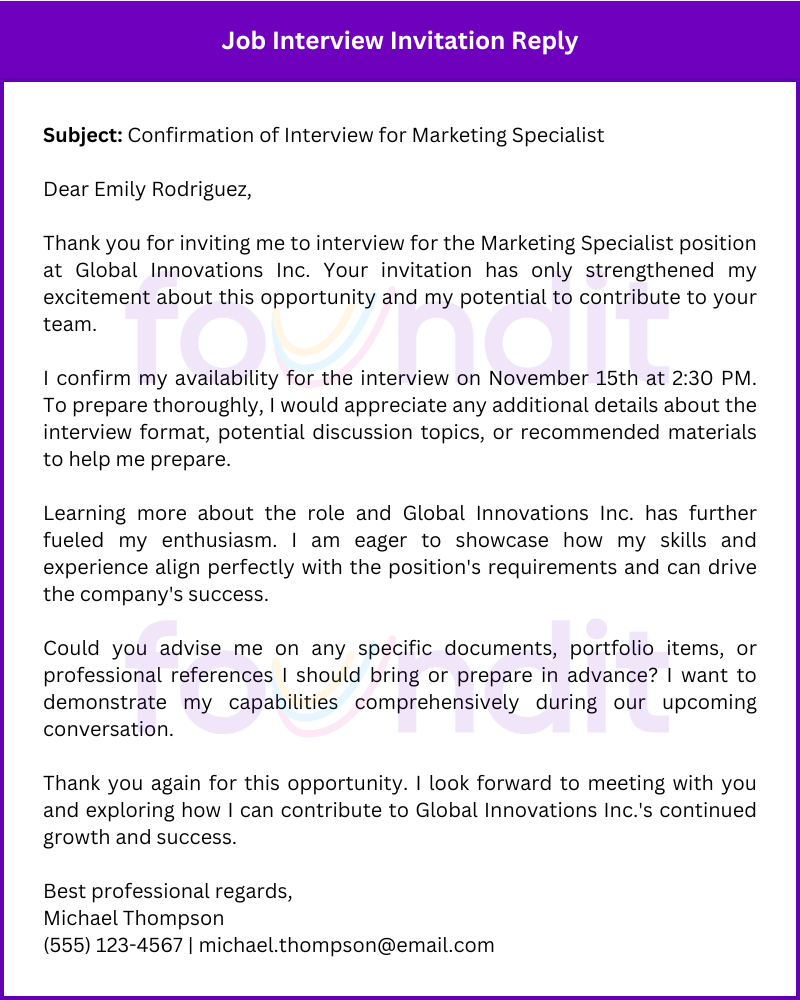
6.2 Client Inquiry Reply
| Subject: Re: Inquiry About Premium Fitness Tracker Dear Emily Rodriguez, We’d like to thank you for your interest in our fitness tracker. We are excited to help you find the perfect solution for your needs. I’ve looked deeply into your inquiry and have a firm response explaining all the details you requested. You’ll find detailed information, including: – Complete product specifications – A front-runner comparison with other options – Answers to questions we are often asked Choosing the right product takes time and thought. For that reason, we have additional resources to give you a complete view of how our fitness tracker will meet your needs. We are dedicated to helping you every step of the way. Of course, if you have any further questions or need more information, please don’t hesitate to get in touch. We’re ready to offer tailored advice to aid you in making the best choice. We are happy about your interest and always ready to assist you further. Warmest professional regards, Michael Thompson Senior Product Specialist HealthTech Innovations |
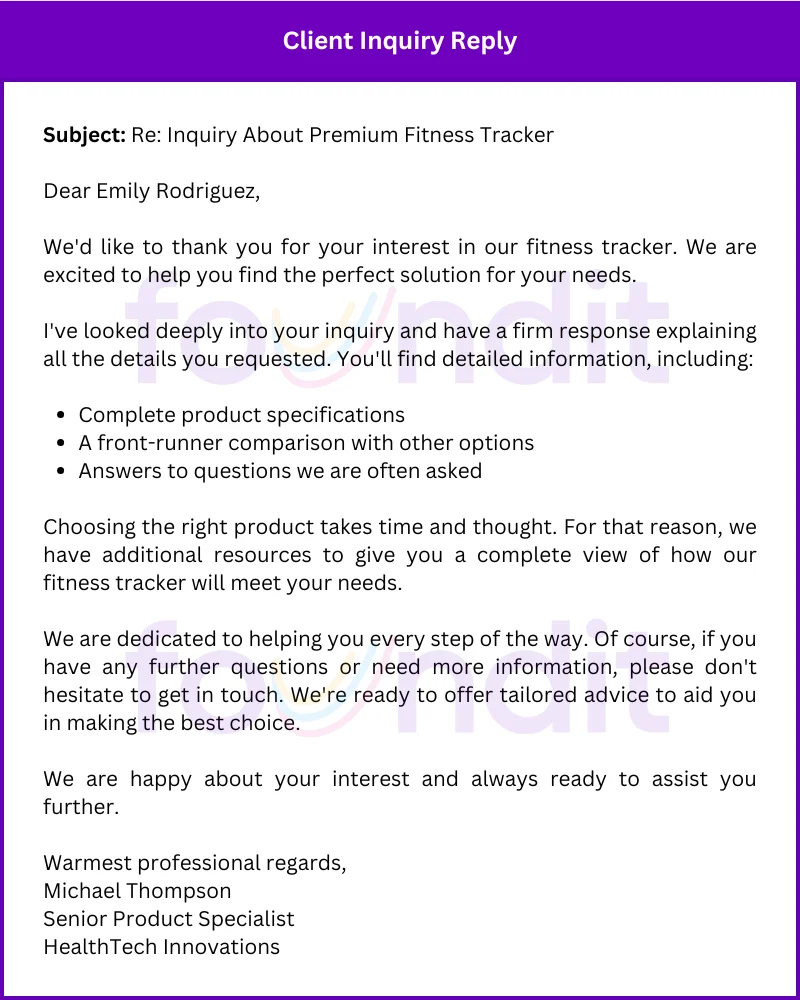
6.3 Meeting Request Reply
| Subject: Meeting Confirmation Dear Emily Rodriguez, Thank you for suggesting a meeting to discuss implementing the marketing strategy. I’m excited to confirm my acceptance and help us nail down the details. I can meet on March 15th at 2:30 PM or connect via Zoom conference call. To make our time together as effective as possible, could you share a brief agenda or outline of the key points you want to cover? I’ll prepare by gathering relevant background materials and developing initial thoughts to support our discussion. Please send any documents or additional context you’d like me to review beforehand. I’m looking forward to our meeting and the chance to work together productively. I’m confident our conversation will be both meaningful and impactful. Best professional regards, Michael Thompson michael.thompson@corporateemail.com |
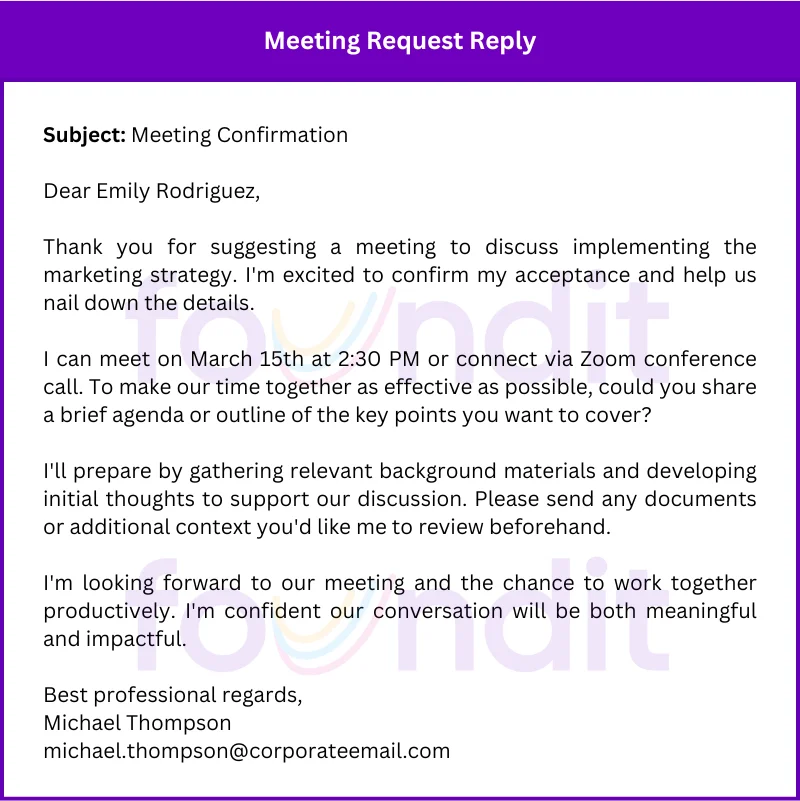
6.4 Follow-Up Email Reply
| Subject: Re: Project Status Update Dear Gwen Stacy, I appreciate your follow-up to the marketing expansion project and your continued interest and patience. I wanted to provide an up-to-date comprehensive round-up of our progress. Our project has reached the following status: We have completed the initial market research phase, conducted a comprehensive competitor analysis, and developed preliminary marketing strategies. Key milestones are complete, and we are focused on the upcoming digital campaign design. We expect to reach the next major milestone on September 15th. I will also keep you in the loop with a highly detailed report detailing our progress, any potential challenges we might encounter, and our plan for overcoming those roadblocks. We remain committed to delivering exceptional results and continuing to be open and clear with communication throughout the project lifecycle. We rely on your continued support and participation to meet our shared success. If you need any additional information or have questions about our current status, please don’t hesitate to reach out directly. Best professional regards, Michael Anderson Senior Marketing Strategist |
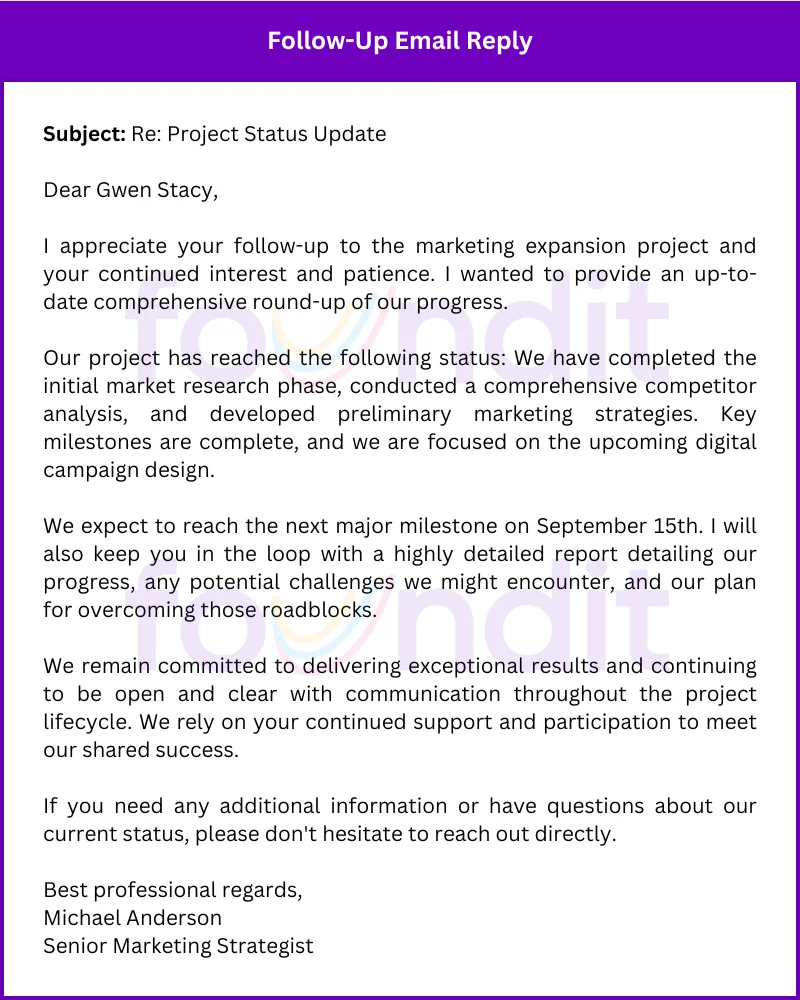
6.5 Thank You Email Reply
| Subject: Re: Thank You Dear Angela Betty, Your appreciation has touched me, and I am genuinely grateful for your kind words regarding our recent marketing campaign. Collaborative efforts like ours make professional experiences meaningful and rewarding. Working together has been an extraordinary opportunity to demonstrate our collective capabilities and achieve remarkable outcomes. Our success is a testament to the power of effective teamwork, mutual respect, and shared professional goals. I am equally excited about potential future collaborations and remain committed to maintaining the high standard of excellence we’ve established. Our professional relationship represents the kind of dynamic, productive partnership that drives meaningful progress. Please know that I am always open to future opportunities where we can combine our skills and expertise to achieve exceptional results. Warmest professional regards, Simon Garfield |
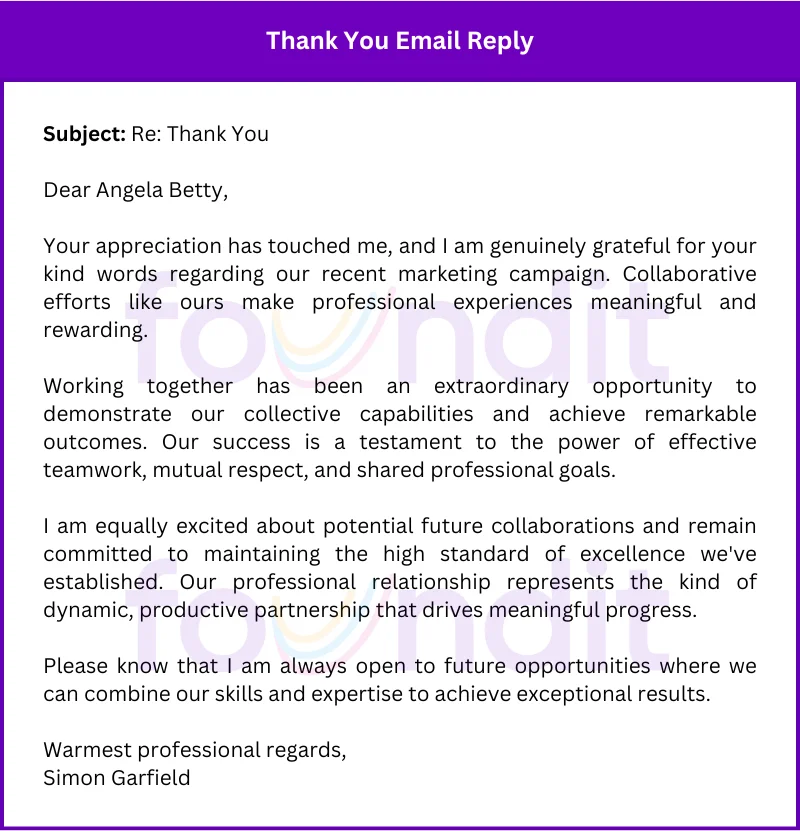
7. Common Mistakes to Avoid in Email Replies
Here are some of the most commonly made mistakes that one must avoid in their email replies:
- Context Oversight: Misinterpreting or completely disregarding the original email’s context leads to ineffective communication. Carefully read and understand the entire message before drafting your reply email to ensure accurate and relevant responses.
- Response Delays: Unnecessary delays in responding can damage professional relationships. Aim to acknowledge emails promptly, even if a comprehensive reply requires more time. Set clear expectations about when a full response will be provided.
- Unprofessional Communication: Maintain a respectful, measured tone in your email reply format. Avoid emotional language, slang, or inappropriate humour. Ensure your communication reflects professionalism and represents your organisation’s standards.
- Proofreading Negligence: Failing to review your message can result in embarrassing errors. Carefully check grammar, spelling, and clarity. How to reply to an email professionally requires meticulous attention to detail and communication quality.
- Response Complexity: Avoid overwhelming the recipient with excessive information. Keep your response clear, concise, and focused. Address the specific points raised, providing only the necessary details to maintain clarity and effectiveness.
Conclusion
Effective email communication is a critical professional skill that extends beyond mere message transmission. Mastering the reply email technique can significantly enhance workplace relationships and personal credibility.
Implementing thoughtful email reply format strategies can transform routine communications into powerful relationship-building opportunities. Consistently practising clear, respectful, and precise communication distinguishes exceptional professionals from average communicators.
Remember that each email represents an opportunity to showcase your professionalism, attention to detail, and interpersonal skills. Investing time crafting meaningful responses demonstrates reliability, competence, and genuine commitment to effective collaboration.
Continuous email communication improvement is a professional growth journey that yields substantial long-term benefits in personal and organisational success.
People Are Also Interested In:
FAQs on How to Reply to an Email
Q1: How do I respond to a professional email response template?
A1: Use a clear, structured format with a formal greeting, address the sender’s points directly, maintain a professional tone, and conclude with a polite closing.
Q2: How do you respond back to an email example?
A2: Craft a concise, relevant reply that acknowledges the original message, answers all key points, and provides necessary information with clarity and courtesy.
Q3: How do you respond to a well-written email?
A3: Mirror the sender’s professionalism by responding thoughtfully, demonstrating active listening, addressing each point comprehensively, and maintaining a respectful communication style.
Q4: How do you respond to a thank you email template?
A4: Reply promptly with genuine appreciation, acknowledge the sender’s gratitude, and potentially offer additional support or express mutual respect.
Q5: How do you acknowledge a message professionally?
A5: Respond quickly and courteously, confirm receipt, address the message’s content, and provide any necessary follow-up information or next steps.
Q6: How do you reply to an email formally?
A6: Begin with a proper salutation, use clear and concise language, structure your response logically, proofread for errors, and end with a professional sign-off.


